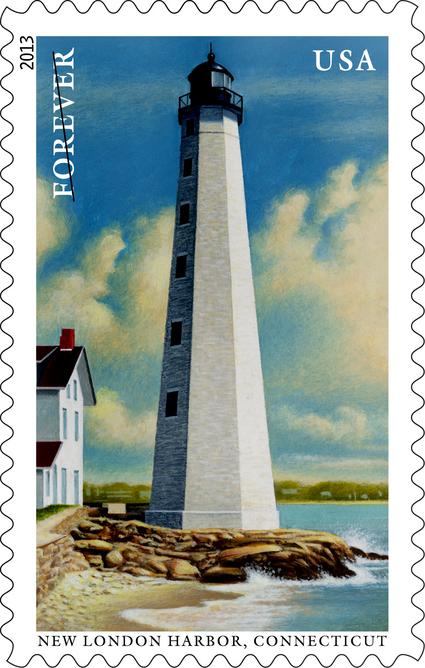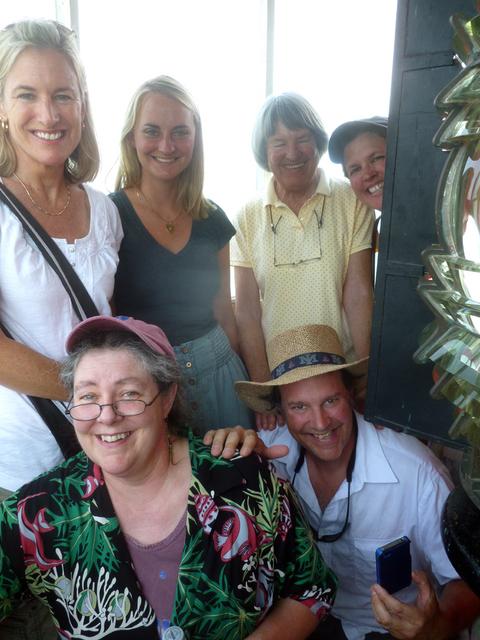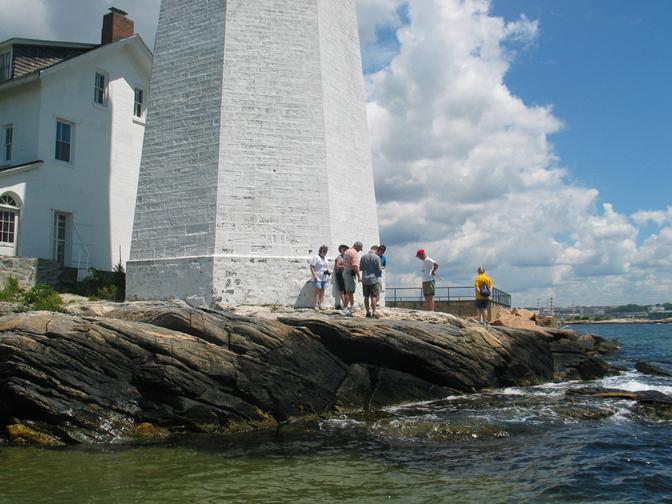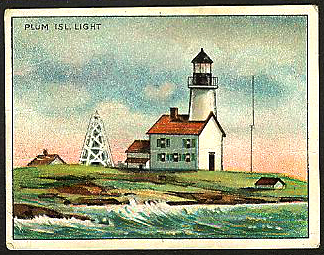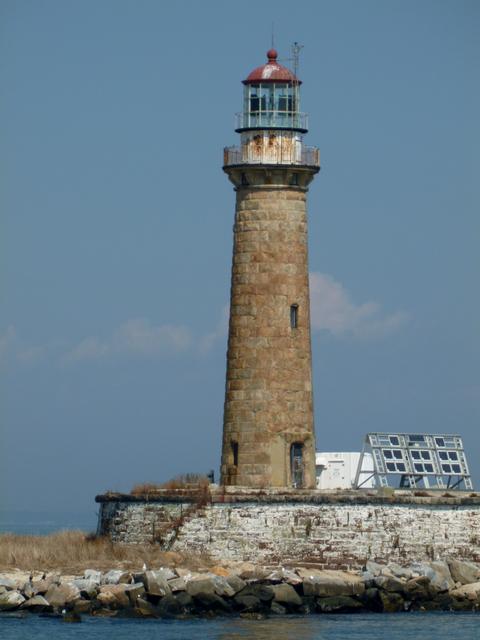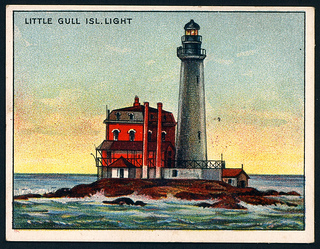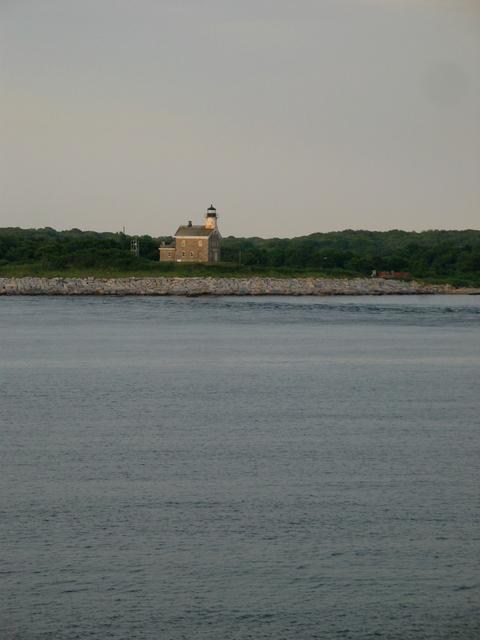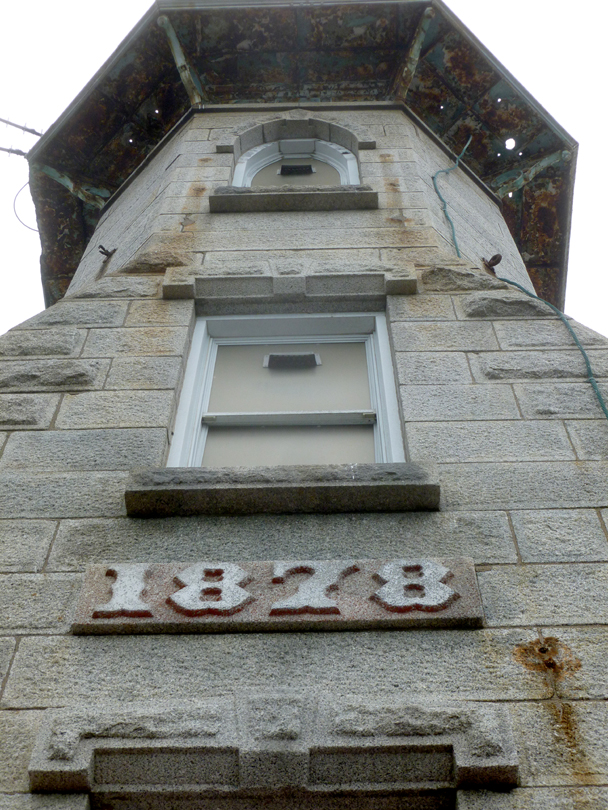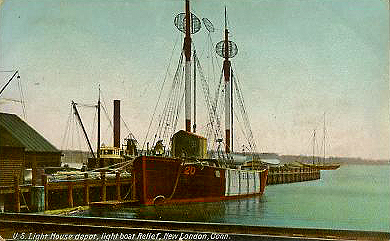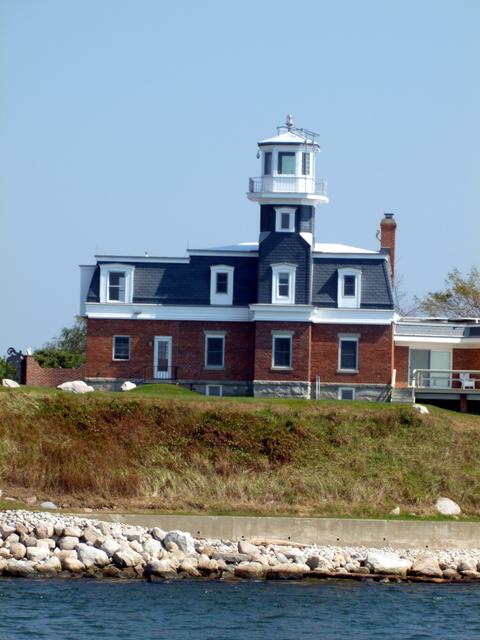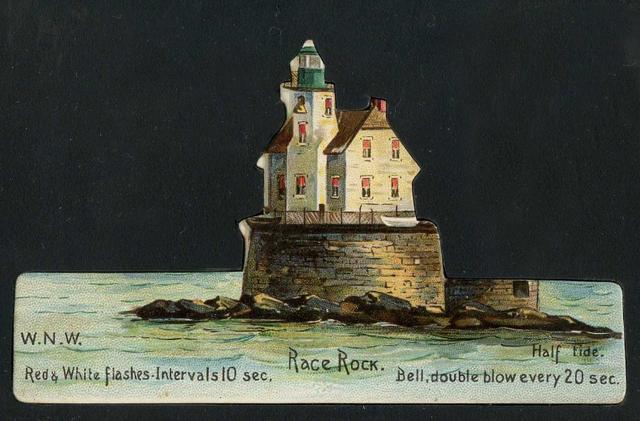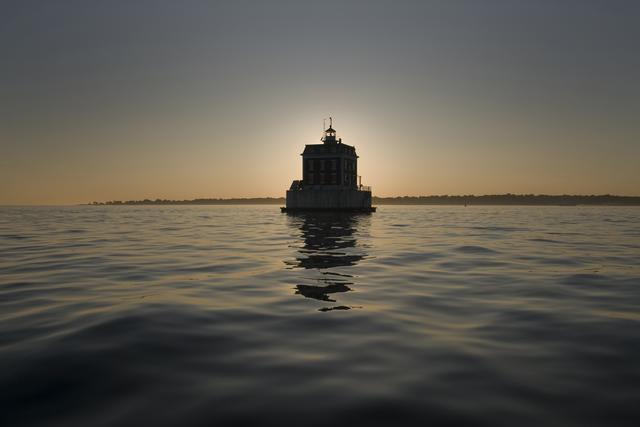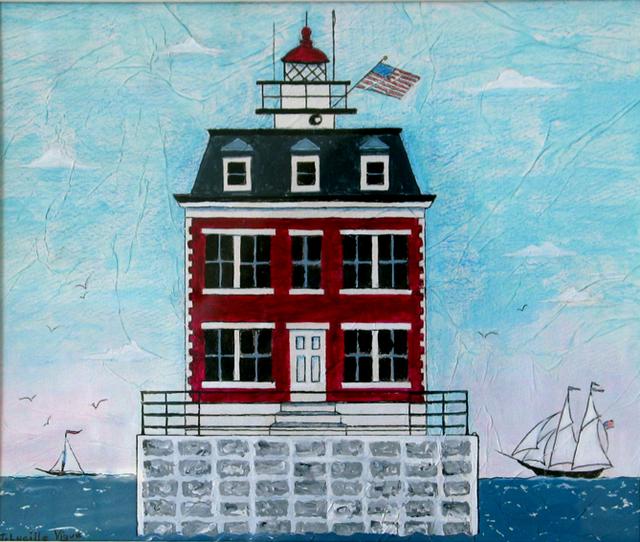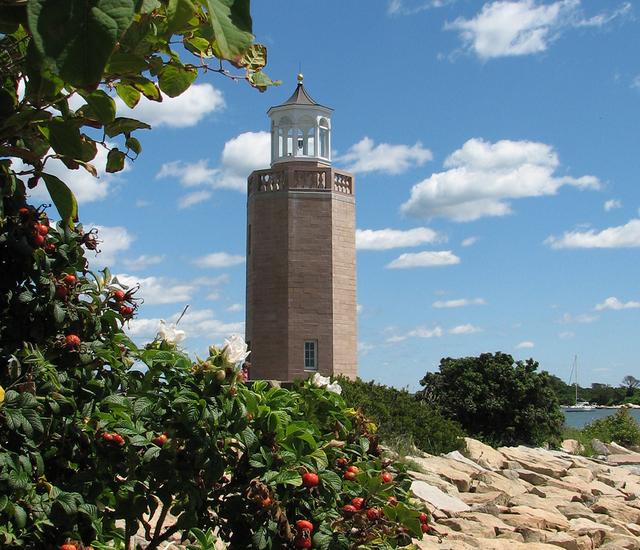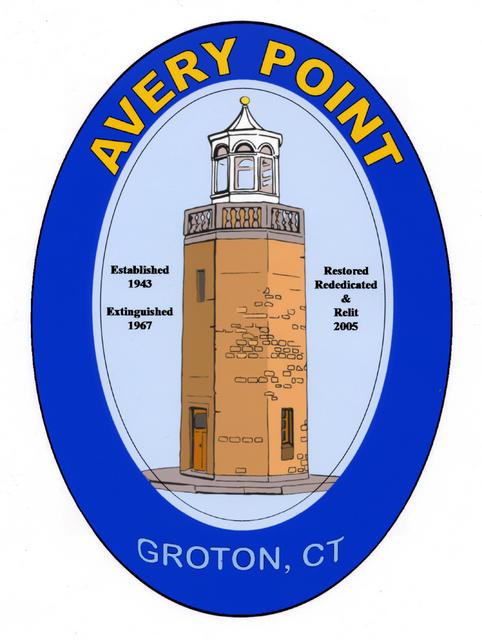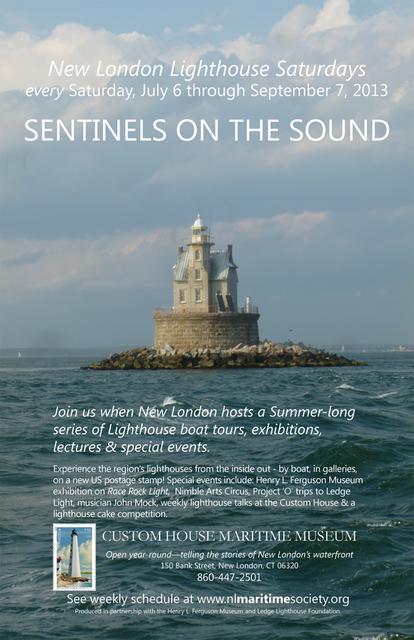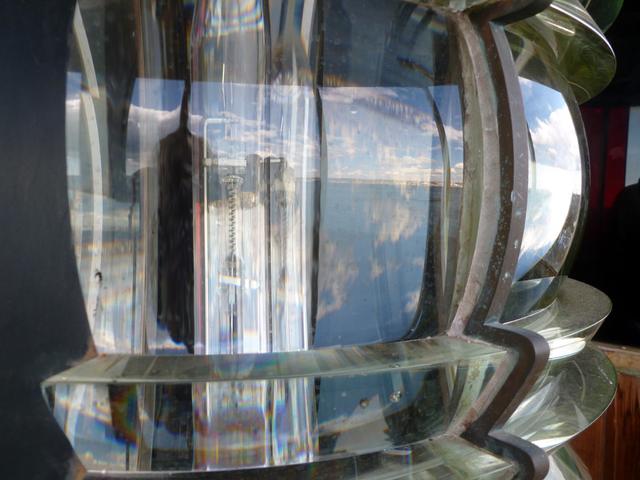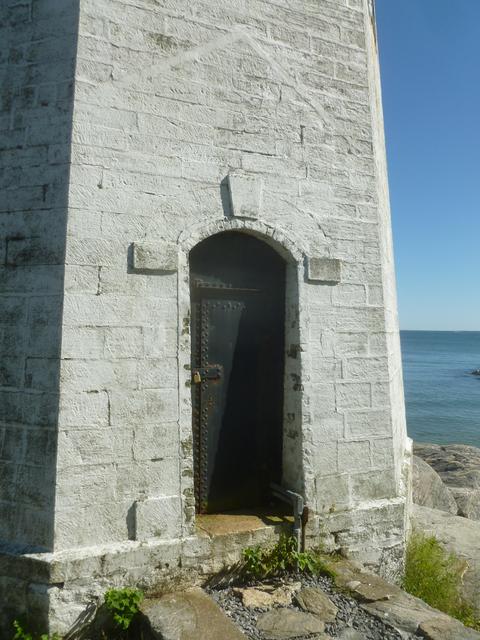Boat tours, special events, lighthouse talks every Saturday - for 10 weeks -
July 6 through September 7, 2013.
One-hour boat trips to New London Harbor Light (with a climb up to the lantern) take place Saturdays at 11 AM, 1 & 3 PM (every Saturday except July 13 - SailFest). One-hour Harbor Lighthouse tours take place at 12 noon and 2 PM. Six passengers, only, per trip. Tickets are $35 for adults, $25 children age 14 and younger. All proceeds, beyond boat costs, go to the Lighthouse Restoration Fund.
To make reservations, please call 860-447-8700, or or email [email protected]. Payment will be accepted over the phone or through Paypal. (In the email, please specify which tour you would like to book.)
~ A new Race Rock Light exhibition opens at the Henry L Ferguson Museum, Fishers Island, on Sunday, June 30. Check for hours on the museum website. The exhibition will remain on view through May 2014.
We have two Fishers Island trips scheduled to see the museum exhibition, including lunch at the Pequot Inn: July 6 and July 27, from 10 AM to 2 PM.
~ Join our Plum Island tour, Friday, August 30.
This is an exciting chance to visit a naturally beautiful and historically secretive location. The tour will encompass the entire 840 acre island, including visiting Fort Terry (est. 1897). Lunch is included! All guests meet at the Old Saybrook One Harbor at 7 AM for the ferry.
A federal background check must be completed, please sign up 30 days in advance. Contact for required information is Rachel: [email protected]. The tour is vigorous, including riding a bumpy school bus ride, and walking on dirt and gravel paths through woods. Please make sure you are sure footed and wear appropriate shoes (no open toed shoes or sandals). Cameras and cell phones are not permitted on the island, so leave those items behind. Pictures will be taken by tour guides at appropriate locations! Tour price is $25.
~ The City of New London just booked the USCG Dixieland Jazz Band for a free concert series on the New London Waterfront Park this summer. Two concerts coincide with our Lighthouse Saturdays, 3-4:30 PM: July 6, & Aug 3,
~ Sweeties Bakery & Cafe, a Lighthouse Saturday Partner just announced they will be offering Lobster rolls this summer on all of our Lighthouse Saturdays.
~ The Freedom schooner Amistad will visit the Custom Pier on Saturday, July 6. A special concert: Beacons of Light & Hope, by pianist Martin Berkofsky benefits both our Lighthouse Restoration Fund and Amistad America.
This event is sponsored by Veolia - New London Water Authority - A Lighthouse Saturday Sponsor
~ The release of the new USPS Forever postage stamp featuring New London Harbor Light will take place during SailFest, Saturday, July 13, (at 10 AM) beneath the Custom House Maritime Museum tent. A new cachet, designed by Alan Bentz, will be available for purchase for $5 and it can be cancelled at this time.
~ Two-hour boat trips to visit Ledge Light will take place July 20, August 17, & September 7, 2013, at 4 PM. Meet at the Custom House; boats leave from the Custom House Pier. Reservations are necessary, call: 860-445-9007 or 800-364-8472 for tickets.~ Lighthouse Talks take place on July 27, August 24 and September 7 at 5 PM.
~ Lighthouse Talks take place on July 27, August 24 and September 7 at 5 PM.
~ A Lighthouse Talk by Todd Gipstein, president of the Ledge Light Foundation, takes place on July 27 at 5 PM.
~ Renowned musician and photographer John Mock will present his unique multimedia maritime concert presentation From The Shoreline at the Custom House Maritime Museum in New London, CT, Saturday August 3, at 5 PM.
~ Nimble Arts Circus - prepare to be amazed! Presented on Waterfront Park in partnership with the City of New London, Saturday, August 10, 2013; Juggling Workshop 2-3 PM; two performances: 4-4:45 PM & 6:30-7:15 PM. This event is sponsored in part by a grant from Veolia - New London Water Authority.
~ A Lighthouse Talk by Doug Allen, a former USCG Lighthouse Keeper, takes place on August 24 at 5 PM.
~ A Lighthouse Talk by Pierce Rafferty, curator of the Henry L. Ferguson Museum and the new Race Rock Light exhibition, takes place on September 7 at 5 PM.
Sponsors/Partners include: Veolia Water / New London Water Authority, Hefel Masonry LLC, Captain Scott’s Lobster Dock, CT Rides, and the Fishers Island Ferry.
The waters leading into New London Harbor contain a rich variety of lighthouses, from the oldest and tallest on Long Island Sound, to some of the newest and more-unusual designs. Some of these lighthouses are still active Aids to Navigation, a few are privately owned; several can be visited both by land and by sea. These days, lighthouse keepers are a thing of the past. Active lighthouses are managed by the United States Coast Guard.
Learn more about New London-area lighthouses. There are several places nearby to explore. The closest of these is in downtown New London.
The New London Maritime Society’s Custom House Maritime Museum (two blocks from the NL train station at 150 Bank Street) presents a permanent exhibition about area lighthouses and also owns New London Harbor Light. Tours can be scheduled to visit the lighthouse by land year-round, and by boat during nine Sentinels on the Sound: Lighthouse Saturdays, every Saturday in July & August, 2013. This summer, New London Harbor Light is the Connecticut beacon featured on a USPS stamp. Watch this page, after May 1, to find out more about our boat trips, lectures & other special lighthouse events.
The United States Coast Guard Museum, in Waesche Hall at the U.S. Coast Guard Academy in New London, contains exhibitions about lighthouses lenses, the US Lifesaving and Lighthouse Services. Admission to the museum is free but you will need a government-issued photo identification to enter the campus. Call 860-444-8511 or visit the website at www.uscg.mil/ hq/cg092/museum to learn more.
Fort Trumbull State, Park 90 Walbach Street, New London, exhibits three scale models of area lighthouses on display in the Visitor Center. Crafted by Robert A. Landry of Salem, the lighthouse models include New London Harbor Light, New London Ledge Light and Race Rock Light. On a clear day, two of the actual lighthouses can be seen from the park. 860-444-7591.
New London Ledge Light, located in the Thames River, contains an information center and can be visited by boat through Project Oceanology on Avery Point in Groton. In addition to the three tours from New London, July 20, August 17, & September 7, 2013, at 4 PM, Project ‘O’ runs public tours of Ledge Lighthouse from Groton on Tuesdays, Thursdays & Saturdays in July & August, and just on Saturdays in September. Call 860-445-9007 or 800-364-8472 to reserve tickets. www.ledgelighthouse.org.
From oldest and tallest to newest and smallest – here are the stories of the seven lighthouses closest to New London harbor. Learn more about area lights at the Custom House Maritime Museum.
NEW LONDON HARBOR LIGHT
Location: West side of the entrance to New London Harbor. Nearest city: New London, CT
Station established: 1761, Present lighthouse built: 1801, Automated: 1912
Focal height 90 feet. Owned: New London Maritime Society, 2009.
Established as a beacon at the 'Harbor's Mouth' of the Thames River possibly as early as 1740, New London’s Harbor Light was formally established as a lighthouse in 1759, in the reign of King George II. In 1761, in part with money raised by selling lottery tickets, a 64-foot stone tower with a lantern was erected.
During the American Revolution this light helped guide colonial privateers who sought shelter up the Thames River. As a result of this activity and acting for the British, Benedict Arnold targeted and burned the City of New London and nearby Fort Griswold in 1781. Arnold’s troops landed near the lighthouse.
New London Harbor Light was the fourth lighthouse recognized by President George Washington, when he enacted the 1789 Act for the Establishment and support of Lighthouse, Beacons, Buoys, and Public Piers.
By 1799, the lighthouse developed a large crack and there also were complaints that the light was difficult to distinguish from neighboring homes. The current octagonal tower, designed by Abisha Woodward (1752-1809) of New London, was constructed of brownstone in 1801. New London Harbor Light was one of the earliest American lighthouses with a flashing light. The revolving eclipser gave it a distinct characteristic so it couldn't be confused with the lights of nearby houses. The light still alternates 6 seconds on, 6 seconds off.
New London Harbor Light was extinguished during the War of 1812 at the request of Commodore Decatur. With the militia nearby the British decided not to raid the lighthouse, but they did raid Little Gull Island Light farther out in Fishers Island Sound.
This lighthouse is historically significant as the site of numerous tests for lighting apparatus and fog-signal devices used by the Federal Lighthouse Service
.
The keeper's quarters were constructed in 1863 (enlarged in 1900). The station was automated in 1912.
The lighthouse is mentioned in Eugene O'Neill's play Ah Wilderness, and its former foghorn in the New London playwright's Long Day's Journey Into Night.
In 2009, the New London Maritime Society became owners of New London Harbor Light. The formal conveyance took place October 13, 2010. Though the Coast Guard continues to maintain the automated beacon in the lantern, the Society (which also runs the New London Custom House) is now the keeper of the lighthouse. Through partnerships with groups such as New London Public Schools and Sea Scouts of America Ship 584 in Groton, the NLMS provides access, education and preservation of this important example of maritime technology and American history.
Tours of the lighthouse by land can be arranged; call 860-447-2501 to schedule.
In summer months, lighthouse tours by boat are available on special Lighthouse Weekends.
In his excellent and thorough book - Lights and Legends, a Historical Guide to Lighthouses of Long Island Sound, Fishers Island Sound and Block Island Sound, Mr. Harlan Hamilton states: “Today, New London Harbor Light is one of the country’s most attractive landmarks. The tower remains substantially the same as when it was built in 1801 and is one of the finest masonry lighthouses still in existence.”
While standing at the foot of the tower, five other lighthouses can be seen from New London Harbor Lighthouse. Depending on the weather conditions, the glow from the beacons of at least two other lighthouses can be seen at night. ≡
LITTLE GULL ISLAND LIGHT
Location off Fisher's Island, New York
Station established: 1805, Automated: 1978
Focal height 91 ft. Owned privately.
Offered for public auction by US gov. in 2012.
Little Gull Island is the last little mound of land above seawater at the tip of Long Island’s north fork. The original lighthouse built here was completed in 1805 by Abasha Woodward of New London, the same builder who erected the New London Harbor Light 4 years before. The lighthouse keeper’s dwelling was a 3 room affair that housed the keeper, his wife and children as well as the assistant keeper, his wife and any children they may have had. It is reported that all of these people were confined together in this house for up to 2 months at a time during the New England winters.
During the War of 1812 the British squadron blockading Long Island Sound sent ashore a landing party that stole or destroyed everything on Little Gull Island except the stone light tower. When the war ended in 1814 the station was rebuilt, the lamps were replaced in the lighthouse and the keeper, assistant keeper and their families moved back onto the island only to endure having it all destroyed again in the great hurricane of September 23rd, 1815! The people saved themselves from being washed away with the keeper’s house and much of the island itself by taking refuge in the lighthouse tower.
The beleaguered 53-foot tall tower was torn down after the Civil War at the order of the Lighthouse Service and in its place the 81 foot tall tower that stands today was finished in 1868. The fine, brick 3-story keeper’s house built along with the new tower was destroyed by fire in the mid-1940s.
Little Gull Island Lighthouse is one of the last masonry light towers to be built on the east coast and incorporates in its design stylization and new materials (such as the cast-iron spiral stairway believed to be original) of the 1860s that serve as an example of lighthouse technology in transition.
No longer do keepers and their families submit to the isolation and dangers of living on Little Gull Island. Through automation technology the lighthouse continues its work in stately solitude. ≡
PLUM ISLAND LIGHTHOUSE
Location: on Plum Island, in Gardiners Bay, east of Orient Point, off the eastern end of the North Fork coast of Long Island, New York.
Station established: 1827, Automated: 1978
Focal height 60 ft. Owned: US federal government.
Plum Island is the largest of three islands that extend from the North Fork of Long Island northeasterly into Long Island Sound. The island was the site of the first battle between British and colonial troops during the Revolutionary War.
Plum Island Lighthouse stands on three-acres at the west end of Plum Island and marks the east side of Plum Gut, a mile-wide entrance to Long Island Sound with extremely strong tidal currents. Orient Point lies on the opposite side of Plum Gut.
The first lighthouse on Plum Island was a thirty-five foot tower built of rough stone in 1827. Ten lamps with reflectors, divided into two groups of five and arranged on rotating copper tables, served as the tower's lighting apparatus. In 1856, the lamps were replaced by a sixth-order Fresnel lens. An eight-room keeper’s dwelling stood separate from the tower.
The Annual Report of the Lighthouse Board for 1868 records, “both the tower and keepers dwelling are in bad condition and should be rebuilt.” Funds were soon allocated for a replacement, which went into operation in 1869.
The new lighthouse consisted of a granite, two-story dwelling, with a white cast-iron tower, capped by a black lantern room, attached to the front of the dwelling's pitched roof. The sixth-order Fresnel lens from the old lighthouse was transferred to the new one, and then upgraded to a fourth-order lens in 1897. The old keeper's dwelling remained standing until 1882. Since the locations that required lighthouses also often had strategic military significance, a number of light stations found themselves with military bases as neighbors. A tradition developed that allowed lighthouse keepers to purchase food and supplies from the base commissaries to save them a longer trip to a more populated area. William Chapel became keeper at Plum Island in 1913 and was accustomed to buying his provisions at Fort Terry, located on Plum Island just east of the lighthouse. However, in 1916 Chapel was suddenly informed that he no longer had privileges at the military base. This forced him to take his small boat two miles over water to Orient Point, or sometimes all the way to New London, twelve miles across Long Island Sound. Other lighthouse keepers were similarly affected by the new rule, and the Lighthouse Board had to intervene on a case-by-case basis. Eventually, Chapel and most other keepers regained their access to the bases.
Fort Terry had little value following World War II, and the Army turned the property over to the U.S. Department of Agriculture, which now operates the Plum Island Animal Disease Center on the island. Coast Guard personnel were removed from Plum Island in 1978, and the lighthouse was replaced by a flashing white light mounted on a 14-foot-tall brick shed. The lighthouse was not maintained after its closure and soon fell into disrepair.
In 1994, the Fresnel lens and its clockwork mechanism were taken out of the tower and put on display at the East End Seaport Museum in Greenport.
Erosion of the bank in front of the station caused a generator house to fall into the water in 1997, and not long thereafter the lighthouse itself was at risk. In 2000, East End Lighthouses was formed to spearhead the restoration and reactivation of the Plum Island Lighthouse. The group has arranged for 15,000 tons of rocks to be brought to the island for the purpose of shoring up the bank and stopping further erosion. East End Lighthouses is working with the Department of Homeland Security, which now controls Plum Island, to restore the venerable lighthouse. The island is off limits to the public, so the lighthouse can only be seen from the water. ≡
RACE ROCK LIGHTHOUSE
Location Fisher's Island Sound in Long Island Sound, New York
Station established: 1871, Automated: 1959
Focal height 60 ft. Offered for ‘adoption’ by US government in 2011.
This wonderful granite lighthouse erected on a mostly submerged ledge at the western end of Fishers Island was completed in 1878 after seven years of amazing determination on the part of the engineers and builders, among these New London’s Captain T.A. Scott. Strong, fast currents at this location (hence the name The Race) and conflicting seas are the normal conditions here where Long Island Sound, Block Island Sound and Fishers Island Sound all meet. Due to the large losses in lives, ships and cargo on the ledge over the years it was decided that a lighthouse was essential regardless of the difficulty and expense in building it.
Appointed as Race Rock Lighthouse Keeper in 1880 Thomas A. Carroll would row his boat across Fishers Island Sound to Noank for supplies and to visit his family. In January of 1885 a severe storm blew in catching Mr. Carroll ashore. The storm lasted several days and finally the Keeper decided he could stay away from his duties at the lighthouse no longer. He was last seen alive rowing out through the powerful waves alone in his small boat.
The expense and difficulty in building traditional lighthouses in remote and submerged locations brought about the development of the cast-iron caisson foundation for use on such sites. Latimer Reef Lighthouse in Fishers Island Sound is a good example of this type. Race Rock Lighthouse was one of the very last traditional masonry lighthouses to be built in the United States in such a location. ≡
NORTH DUMPLING ISLAND LIGHT
Location: North Dumpling Island, one mile north of North Hill on Fishers Island and 1.5 miles south of Groton Long Point, CT.
Station established: 1871, Automated: 1959
Focal height 60 ft. Owned privately.
Known as North Hummock Island from colonial times into the 20th century, the island is still called this by local fishermen who can, through their intimacy with weather and deep water, be a stubborn breed. The U.S. government bought the island in 1847 in order to build a lighthouse there which, completed in 1849, was a lighthouse tower and keeper’s dwelling combined in one building.
The first keeper of this light was Alfred Clark who, besides his earnings from the Lighthouse Service as keeper, was paid by the New York and Stonington Steamboat Line to ring a large bell the Line had placed on the island to be sounded when one of its steamers was scheduled to pass the island during foggy weather. In 1871 the lighthouse was enlarged and renovated.
The keeper of North Dumpling Island Light during the period of Prohibition, 1920 to 1933, was accused of signaling to vessels known to be smuggling liquor between the mainland and Fishers Island. Though the Coast Guard reportedly saw some strange lights around the station no conclusive evidence was ever brought forth connecting the keeper to illegal activities.
In the devastating hurricane of September 21, 1938 powerful combers pounded away half of the island and the lighthouse was left terribly close to the deeply eroded embankment. However, the lighthouse stood strong long enough for a sea-wall to be built and backfilled thus stabilizing the shore around the structure.
North Dumpling Island and its lighthouse were sold to a private owner in 1959. In the 1980s a subsequent owner remodeled and enlarged the lighthouse altering its appearance considerably. Today the island and lighthouse are owned by Dean Kamen who is famous for, among other things, inventing the Segway Human Transporter. But the beacon in the top of the tower still shines thanks to the care of the U.S. Coast Guard. ≡
NEW LONDON LEDGE LIGHT
Location: Thames River, entrance to New London Harbor. Nearest city:Groton, CT
Station established: 1909, Automated: 1987
Focal height 57 feet. Owned: US federal government.
Known by locals as Ledge Light to differentiate it from the Harbor Light, this popular icon sits in about seven feet of water (at low tide) along the east side of the navigational channel leading in and out of the Thames River. This structure, architecturally unique for a lighthouse, was completed and put into service late in 1909 to mark a troublesome shoal of rock that many vessels had come to grief upon.
Built of red brick and smooth-faced granite with a mansard roof, the lighthouse is an unusual example of French Second Empire style architecture long after the style had been popular in the period 1860-1890. It is an example of a combined light tower and keeper’s dwelling. The Hamilton R. Douglas Co. of New London erected the lighthouse. The company also built the Groton Town Hall.
The original forth-order classical Fresnel lens was made in Paris, France, by Henry Lepaute. The lamp floated on a bed of mercury and was turned by a complex clockwork gear system which was counterweighted with an 85 pound dropping pendulum. The clockwork had to be wound every 4 hours to maintain proper operation of the light. When the present automated 150-watt electrical lamp was installed in 1984 the Fresnel lens was removed. This beautiful lens can be seen at the Custom House Maritime Museum.
Though the Coast Guard maintains the lighthouse beacon, the building is owned and maintained by the New London Ledge Lighthouse Foundation. You may visit the new Ledge Lighthouse Interpretive Center located inside Ledge Light through tours run by Project Oceanology, at University of Connecticut/Avery Point. ≡
AVERY POINT LIGHTHOUSE
Location: East side of Thames River, Pine Island Channel, Groton, CT.
Station established: 1944; Discontinued: 1967; Relit: 2006
Focal height 55 ft. Owned: privately.
This small lighthouse tower, the last lighthouse built in Connecticut, stands at Avery Point on the eastern side of the mouth of the Thames River.
Avery Point was once owned by the wealthy industrialist Morton F. Plant who built an expansive 31 room “cottage” there in 1903 and called it Branford House. He reportedly stayed only a month or two in this place each year, but maintained a staff of 50 there year-round. Avery Point and Branford House became the property of the state of Connecticut which transferred it to the U.S. Coast Guard with the stipulation that a structure be erected on the grounds to serve as an aid to navigation.
Avery Point served as the Coast Guard Training Station (where enlisted personnel received training separate from officer candidates trained at the Coast Guard Academy in New London) from 1942 until the station was relocated to Governors Island, New York in 1967. Students at the station built the 55 foot tall lighthouse tower of concrete block with a wooden lantern gallery surrounded by a cast concrete railing and 32 white Italianate marble balusters salvaged from Mr. Plant’s estate. The lighthouse was finished in 1943 but because of fear of attack during WWII (there is the wreck of a Nazi U-Boat on the bottom of the Sound not far from the Thames River) the beacon wasn’t lit until May 2, 1944.
The light proved useful to those navigating Pine Island Channel and also served a purpose for keepers at Race Rock Light Station out near the west end of Fishers Island. When the fog got so thick that they could no longer see the light at Avery Point, the keepers knew it was time to turn their foghorn on.
The light at Avery Point was discontinued in June of 1967 and the building slowly deteriorated until the American Lighthouse Foundation and the Avery Point Lighthouse Society began raising funds for its restoration in 1999. With a beautiful replica of the wooden lantern gallery built and delivered by West Mystic Wooden Boat Co. and concrete and stone repair completed by Joseph Gnazzo Co. the lighthouse was relit in October of 2006 shining as a memorial to the lighthouse keepers and Coast Guard personnel who have served “illustriously”. ≡
So, at the mouth of the Thames River you have to the west Connecticut’s oldest lighthouse steadily flashing its welcome beacon and on the eastern point the state’s newest lighthouse – lit once again for the aid of boatmen and in the memory of a long and important tradition.
CUSTOM HOUSE MARITIME MUSEUM
150 Bank Street – New London – Connecticut 06405 860-447-2501 nlmaritimesociety.org

